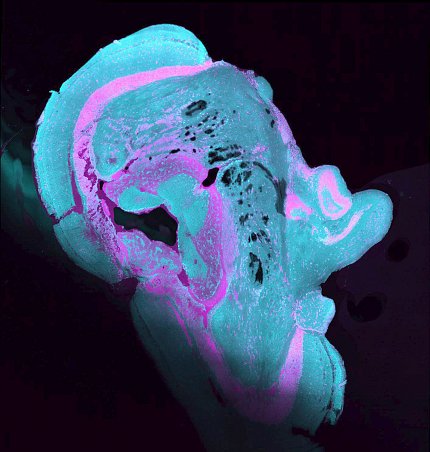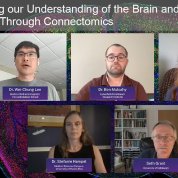BRAIN Convenes to Discuss Open Science, New Tools

The Brain Research Through Advancing Innovative Neurotechnologies (BRAIN) Initiative hosted its 8th annual meeting, Open Science, New Tools, on June 21-22. Marking its third year in an all-virtual format, the gathering brought together more than 2,600 participants—federally funded scientists, leaders and staff, as well as nonfederal organizations, researchers interested in joining the BRAIN community, media and the public.
“The purpose of this open meeting is to continue to build the brain community and provide a forum for discussing exciting new scientific developments and potential new directions and to identify areas of collaboration and research coordination,” said NIH BRAIN director Dr. John Ngai.

The 2-day conference featured plenary lectures, trainee award highlight talks and symposia spanning a range of topics from neuroimmune interactions, neural dynamics of memory formation and rewiring of neural circuitry, to sessions covering the ethical, legal and societal implications of neurotechnologies, to diversity and inclusion opportunities and challenges of human neuroimaging research. The meeting also included presentations on BRAIN Initiative Cell Census Network resources, understanding mechanisms driving internal states and new tools to track and interpret behavior.
In a session organized by the International Neuroethics Society, BRAIN-funded scientists shared experiences collaborating. Another interactive talk hosted by the International Neuroinformatics Coordinating Facility focused on resources such as training, career development and best practices for FAIR (findable, accessible, interoperable, reusable) neuroscience research.
New to the gathering this year: BRAIN researchers used a platform called Zohuddle to connect with each other, expand their networks and develop new collaborations at the “Neuroscientist Speed Dating” event. Meeting attendees also got a chance to watch and discuss the award-winning film The Brain Mappers, which told the story of research teams involved in whole brain connectomics and included first-person accounts from scientists who engaged early in the BRAIN Initiative.

On day one, Ngai joined with NIDCD director Dr. Debara Tucci, NIA director Dr. Richard Hodes and NINDS director Dr. Walter Koroshetz to announce winners from the BRAIN Initiative Challenge. This federal competition encouraged U.S. high school students from all backgrounds to submit essays or videos on the ethical implications of current and developing brain technologies.
Winners presented an overview of their entries, shared their main ethical concerns and participated in a lively discussion with NIH leaders and other meeting attendees.
View the winning entries at: https://www.challenge.gov/?challenge=brain-initiative-2022&tab=winners.
Throughout the meeting, participants were able to interact via Q&A sessions and the web platform’s messaging feature, explore more than 400 interactive posters in the iPosters gallery and chat with the presenters and visit a selection of virtual exhibit booths.
Posters, exhibit materials, broadcasts and resources are available on-demand and at no cost through June 2023 at https://eventmobi.com/brainmeeting2022/.
Winners of the 2022 ‘Show Us Your BRAINS!’ Contest Announced

Photo: STEPHANIE GRELLA
Winners of the “Show Us Your BRAINS!” photo and video contest were announced on the second day.
The contest showcases cool, eye-catching images and videos—some using technologies that were developed with BRAIN Initiative support.
Photo winners include:
• 1st Place: “The Intersection of Memory and Memory” by Stephanie Grella, Boston University. Two memories captured under the microscope. Peering into the hippocampus of a mouse using viral technology and optogenetics.

Photo: SAHAR AHMAD, YE WU, PEW-THIAN YAP
• 2nd Place: “Mindmap—The Intricate Wiring of the Human Brain” by Sahar Ahmad, Ye Wu and Pew-Thian Yap, University of North Carolina at Chapel Hill. Brain activity is orchestrated by propagating information between brain regions through Fiber tracts, visualized via diffusion MRI tractography.
• 3rd Place: “Zebrafish Brain Thinking Abraham Lincoln” by Esengül Öztürk, Çanakkale Onsekiz Mart University. Image taken from a zebrafish brain tissue section, synaptophysin as the primary antibody, Alexa 555 and DAPI as secondary antibody, and looks like Abraham Lincoln’s side profile.

Photo: ESENGÜL ÖZTÜRK
To view the full group of winning images and videos, visit: https://braininitiative.nih.gov/news-events/show-us-your-brains-photo-video-contest.
Launched in 2013, BRAIN is a large-scale effort funded by NIH, other government agencies and private organizations to revolutionize our understanding of the human brain.
A major goal of the BRAIN Initiative is to encourage researchers and organizations from diverse disciplines to work together.
The annual meetings are an important part of this effort.






